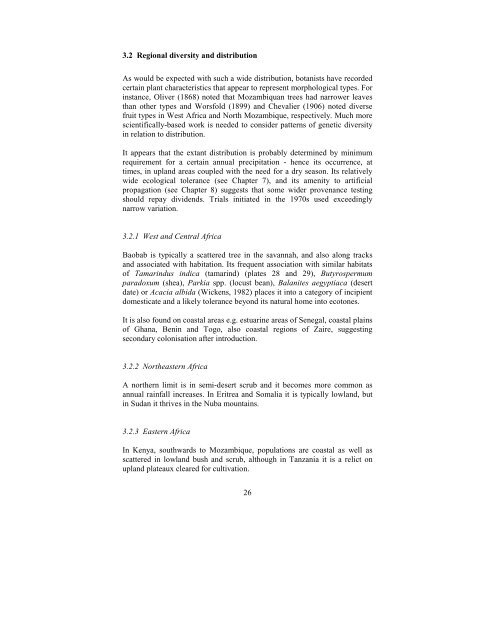Baobab Monograph.pdf - Crops for the Future
Baobab Monograph.pdf - Crops for the Future
Baobab Monograph.pdf - Crops for the Future
Create successful ePaper yourself
Turn your PDF publications into a flip-book with our unique Google optimized e-Paper software.
3.2 Regional diversity and distribution<br />
As would be expected with such a wide distribution, botanists have recorded<br />
certain plant characteristics that appear to represent morphological types. For<br />
instance, Oliver (1868) noted that Mozambiquan trees had narrower leaves<br />
than o<strong>the</strong>r types and Worsfold (1899) and Chevalier (1906) noted diverse<br />
fruit types in West Africa and North Mozambique, respectively. Much more<br />
scientifically-based work is needed to consider patterns of genetic diversity<br />
in relation to distribution.<br />
It appears that <strong>the</strong> extant distribution is probably determined by minimum<br />
requirement <strong>for</strong> a certain annual precipitation - hence its occurrence, at<br />
times, in upland areas coupled with <strong>the</strong> need <strong>for</strong> a dry season. Its relatively<br />
wide ecological tolerance (see Chapter 7), and its amenity to artificial<br />
propagation (see Chapter 8) suggests that some wider provenance testing<br />
should repay dividends. Trials initiated in <strong>the</strong> 1970s used exceedingly<br />
narrow variation.<br />
3.2.1 West and Central Africa<br />
<strong>Baobab</strong> is typically a scattered tree in <strong>the</strong> savannah, and also along tracks<br />
and associated with habitation. Its frequent association with similar habitats<br />
of Tamarindus indica (tamarind) (plates 28 and 29), Butyrospermum<br />
paradoxum (shea), Parkia spp. (locust bean), Balanites aegyptiaca (desert<br />
date) or Acacia albida (Wickens, 1982) places it into a category of incipient<br />
domesticate and a likely tolerance beyond its natural home into ecotones.<br />
It is also found on coastal areas e.g. estuarine areas of Senegal, coastal plains<br />
of Ghana, Benin and Togo, also coastal regions of Zaire, suggesting<br />
secondary colonisation after introduction.<br />
3.2.2 Nor<strong>the</strong>astern Africa<br />
A nor<strong>the</strong>rn limit is in semi-desert scrub and it becomes more common as<br />
annual rainfall increases. In Eritrea and Somalia it is typically lowland, but<br />
in Sudan it thrives in <strong>the</strong> Nuba mountains.<br />
3.2.3 Eastern Africa<br />
In Kenya, southwards to Mozambique, populations are coastal as well as<br />
scattered in lowland bush and scrub, although in Tanzania it is a relict on<br />
upland plateaux cleared <strong>for</strong> cultivation.<br />
26

















